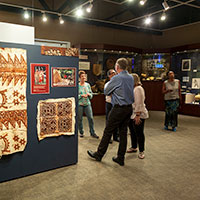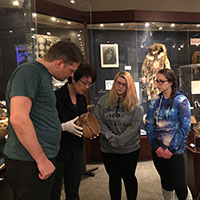 The Santa Rosa Junior College Multicultural Museum is a unique institution in that we are one of only a small handful of museums in the country that is housed in a two year college. Founded in 1939, the SRJC Multicultural Museum has over 5,000 catalogued items, and over 90% of our collection has been donated by community members.
The Santa Rosa Junior College Multicultural Museum is a unique institution in that we are one of only a small handful of museums in the country that is housed in a two year college. Founded in 1939, the SRJC Multicultural Museum has over 5,000 catalogued items, and over 90% of our collection has been donated by community members.
Our holdings include the renowned Elsie Allen Pomo Basketry Collection; Southwest pottery from world famous artists such as Nampeyo, Maria Martinez, and Lucy Lewis; diverse African sculptures and masks; original serigraphs from the Northwest Coast, and original artwork from across the globe.
With only one permanent staff members and a small group of student employees and volunteers, the SRJC Multicultural Museum provides services to over 4,300 visitors per year from the Santa Rosa Junior College and the community at large on a very modest budget.
 Immersive Learning
Immersive Learning
The Museum offers a unique venue for instructors to support student-centered learning.
Art students sketch Puebloan pottery, budding Anthropology students explore artifacts from indigenous societies, and Native American History students use the exhibits to deepen their understanding of Native American cultures. We draw upon our archival collection to create new exhibits to inspire curiosity and serve as a dynamic laboratory for learning.
The Museum also offers opportunities for students to work and volunteer, with immersive, behind-the-scenes experiences that can help them build their resumes while they learn about the Museum field.
- SRJC Collaborations
We love to collaborate with departments on campus! The SRJC Museum has collaborated with the Intercultural Center, The International Student Program, the Anthropology Department, The Women’s History Month Committee, and many individual instructors and departments across multiple teaching disciplines to enhance the educational experiences of our students with exhibits and programming.
- Native Community Outreach
We are happy to provide a comfortable space for our Indigenous community members to reflect and to study their ancestors' baskets and other cultural objects. We are available to set up appointments to pull items out of exhibits and the archives for the purpose of study.
- Children's Outreach Tours
The Museum offers fun, exploratory activities designed for 3rd and 4th grade classes to help meet state core curriculum on Native American cultures and Native Californians. Kids have hands-on experiences with mortars and pestles, pump drills, story time, and Native California "gambling" games. Learn more
- Repatriation Work
The SRJC Multicultural Museum is dedicated to the work of repatriation of sacred objects, objects of cultural patrimony, and funerary objects to their tribal homes. We are in full legal compliance with the Native American Graves Protection and Repatriation Act (NAGPRA) and CalNAGPRA, and have reached out to over 150 different tribes throughout the United States and California, inviting tribal consultations on our collections.
- Museum Name Change
Statement about the Museum Name Change, from the "Jesse Peter Multicultural Museum" to the "SRJC Multicultural Museum"
In the summer of 2020, the college administration received a letter signed by multiple local tribes, asking us to consider the negative impact that museum founder Jesse Peter had on indigenous people in Northern California.
The original museum, started by Jesse Peter in 1939, mainly featured exhibits of rocks and minerals, with some natural history exhibits. Today's museum bears very little resemblance to the museum of the 1940s.
Jesse Peter built his collections during the 1930s when it was not uncommon for archaeologists to believe that they were saving "found" cultural objects by collecting them and putting them in museums. It was the belief of many of Jesse Peter's contemporaries (and likely Peter himself) that Native American cultures were dying out, and that by collecting these objects for museums, they were "saving" them for future generations. However, it is now understood that the manner in which these items were appropriated was culturally insensitive and disrespectful of the Native American communities from which they were taken.
The academic and museum worlds no longer subscribe to the methods and philosophies of the early 20th Century, and recognize that Native American voices are a critical piece of contemporary society. By removing Jesse Peter's name, we are clearly stating our opposition to the historical and systematic desecration of tribal cultural resources and history, which is counter to the college's mission of inclusivity and diversity.